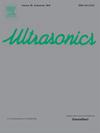Transcranial adaptive aberration correction using deep learning for phased-array ultrasound therapy
IF 3.8
2区 物理与天体物理
Q1 ACOUSTICS
引用次数: 0
Abstract
This study aims to explore the feasibility of a deep learning approach to correct the distortion caused by the skull, thereby developing a transcranial adaptive focusing method for safe ultrasonic treatment in opening of the blood–brain barrier (BBB). However, aberration correction often requires significant computing power and time to ensure the accuracy of phase correction. This is due to the need to solve the evolution procedure of the sound field represented by numerous discretized grids. A combined method is proposed to train the phase prediction model for correcting the phase accurately and quickly. The method comprises pre-segmentation, k-Wave simulation, and a 3D U-net-based network. We use the k-Wave toolbox to construct a nonlinear simulation environment consisting of a 256-element phased array, a small piece of skull, and water. The skull sound speed sample combining with the phase delay serves as input for the model training. The focus volume and grating lobe level obtained by the proposed approach were the closest to those obtained by the time reversal method in all relevant approaches. Furthermore, the mean peak value obtained by the proposed approach was no less than 77% of that of the time reversal method. In this study, the computational cost of each sample’s phase delay was no more than 0.05 s, which was 1/200th of the time reversal method. The proposed method eliminates the complexity of numerical calculation processes requiring consideration of more acoustic parameters, while circumventing the substantial computational resource demands and time-consuming challenges to traditional numerical approaches. The proposed method enables rapid, precise, and adaptive transcranial aberration correction on the 3D skull-based conditions, overcoming the potential inaccuracies in predicting the focal position or the acoustic energy distribution from 2D simulations. These results show the possibility of the proposed approach enabling near-real-time correction of skull-induced phase aberrations to achieve transcranial focus, thereby offering a novel option for treating brain diseases through temporary BBB opening.
基于深度学习的经颅自适应畸变校正相控阵超声治疗。
本研究旨在探讨利用深度学习方法纠正颅骨畸变的可行性,从而开发一种经颅自适应聚焦方法,用于血脑屏障打开(BBB)的安全超声治疗。然而,像差校正往往需要大量的计算能力和时间来保证相位校正的准确性。这是由于需要求解由众多离散网格表示的声场演化过程。为了准确、快速地校正相位,提出了一种组合训练相位预测模型的方法。该方法包括预分割、k波仿真和基于三维u -net的网络。我们使用k-Wave工具箱构建了一个非线性仿真环境,该环境由256个单元相控阵、一小块头骨和水组成。颅骨声速样本结合相位延迟作为模型训练的输入。在所有相关方法中,该方法得到的焦点体积和光栅瓣电平与时间反转法得到的结果最接近。此外,该方法获得的平均峰值不小于时间反转方法的77%。在本研究中,每个样本相位延迟的计算成本不大于0.05 s,是时间反转方法的1/200。该方法消除了需要考虑更多声学参数的数值计算过程的复杂性,同时避免了传统数值方法的大量计算资源和耗时挑战。该方法能够在基于颅骨的三维条件下实现快速、精确和自适应的经颅像差校正,克服了从二维模拟中预测焦点位置或声能分布的潜在不准确性。这些结果表明,所提出的方法可以近实时地校正颅骨诱导的相位畸变,从而实现经颅聚焦,从而为通过临时血脑屏障开放治疗脑部疾病提供了一种新的选择。
本文章由计算机程序翻译,如有差异,请以英文原文为准。
求助全文
约1分钟内获得全文
求助全文
来源期刊

Ultrasonics
医学-核医学
CiteScore
7.60
自引率
19.00%
发文量
186
审稿时长
3.9 months
期刊介绍:
Ultrasonics is the only internationally established journal which covers the entire field of ultrasound research and technology and all its many applications. Ultrasonics contains a variety of sections to keep readers fully informed and up-to-date on the whole spectrum of research and development throughout the world. Ultrasonics publishes papers of exceptional quality and of relevance to both academia and industry. Manuscripts in which ultrasonics is a central issue and not simply an incidental tool or minor issue, are welcomed.
As well as top quality original research papers and review articles by world renowned experts, Ultrasonics also regularly features short communications, a calendar of forthcoming events and special issues dedicated to topical subjects.
 求助内容:
求助内容: 应助结果提醒方式:
应助结果提醒方式:


